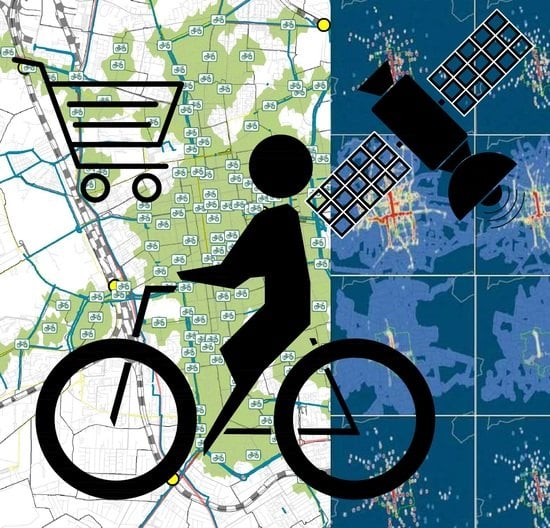Changes in Urban Mobility Related to the Public Bike System with Regard to Weather Conditions and Statutory Retail Restrictions
Abstract
1. Introduction
2. Theoretical Foundations
2.1. Statutory Sunday Retail Restrictions—The Idea, Purposes, Principles, and Effects
2.2. The Bicycle as Part of the Urban Transport System
2.3. The Cyclists’ Transport Behaviour–Determinants and Key Features
- The quality, network, and cohesion of the infrastructure;
- The spatio-functional structure of the city (location of destinations and starting points, including shops);
- Population density;
- Environmental factors, including weather conditions (ambient temperature, exposure to the elements, wind speed, and precipitation), and hilliness;
- Travel safety (objective and subjective);
- A given city’s cycling policy;
| Determinants | Influence Mode Choice | References |
|---|---|---|
| Hilliness | Less cycling with hills | Hunt and Abraham (2007) [39]; Rietveld and Daniel (2004) [40]; Stinson and Bhat (2003) [41] |
| Season | More cycling in summer and autumn (20% to 10%, 40% to 25%, differs between locations) | Guo et al. (2007) [42]; Stinson and Bath (2003) [41] |
| Temperature | Unpleasant temperature corresponds with less cycling Cold more unpleasant than heat | Bergström and Magnussen (2003) [43]; Brandenburg et al. (2004) [44]; Miranda-Moreno and Nosal (2011) [45]; Nankervis (1999) [46] |
| Rain | Negative effect on cycling Delayed impact of rain on cycling | Ahmed et al. (2012) [47]; Bergström and Magnussen (2003) [43]; Brandenburg et al. (2004) [44]; Miranda-Moreno and Nosal (2011) [45]; Nankervis (1999) [46] |
| Climate | Continental climates generally have larger seasonal contrasts (hotter summers, colder winters) but smaller day-to-day weather fluctuations. In continental climates, we expect larger effects from seasonality on travel behaviours, whereas day-to-day weather effects are larger in temperate climates. | Böcker et al. (2013) [48] |
3. Research Area
3.1. Outline of the Socio-Economic Characteristics of Łódź
3.2. Description of Retail Trade
3.3. Environmental Determinants
3.4. Łódź Public Bike-Share Scheme against the Background of the City’s Transport System—Development, Management, and Exploitation
4. Materials and Methods
5. Results and Discussion
- On weekdays, the first wave of traffic can be observed from 7 a.m., reaching its peak at 9 a.m. and followed by a gradual decline in trips until 11 a.m., which is then followed by another increase that lasts 6 h (peak at 5 p.m.), followed by a steady and later rather dramatic drop.
- On weekends, relatively high values (when compared to weekdays) are observed in the first hour of the day (on average, 3% of daily trips are taken between midnight and 1 a.m.), and then there is a continuous decline until morning hours, when traffic begins to increase, reaching its peak between 6 and 7 p.m. After this, the number of trips begins to drop, and in the final hour of the day reaches values lower than the average for the first hour of the day.
6. Conclusions
Author Contributions
Funding
Institutional Review Board Statement
Informed Consent Statement
Conflicts of Interest
References
- Piotrowicz, K. The Occurrence of Unfavorable Thermal Conditions on Human Health in Central Europe and Potential Climate Change Impacts: An Example from Cracow, Poland. Environ. Manag. 2009, 44, 766–775. [Google Scholar] [CrossRef] [PubMed]
- Skuterud, M. The impact of Sunday shopping on employment and hours of work in the retail industry: Evidence from Canada. Eur. Econ. Rev. 2005, 49, 1953–1978. [Google Scholar] [CrossRef]
- Dijkgraaf, E.; Gradus, R. Collusion in the Dutch waste collection market. Local Gov. Stud. 2007, 33, 573–588. [Google Scholar] [CrossRef]
- Genakos, C.; Danchev, S. Evaluating the Impact of Sunday Trading Deregulation Christos Genakos Svetoslav Danchev. In CEP Discussion Paper; Centre for Economic Performance (CEP): London, UK, 2015. [Google Scholar]
- Stelina, J. Legal restrictions on work on Sundays and festive days in Poland. Istor. Cult. Cetatenie Un. Eur. 2018, 11, 105–114. [Google Scholar]
- Borowska-Stefańska, M.; Kowalski, M.; Wiśniewski, S. Changes in urban transport behaviours and spatial mobility resulting from the introduction of statutory Sunday retail restrictions: A case study of Lodz, Poland. Morav. Geogr. Rep. 2020, 28, 29–47. [Google Scholar] [CrossRef]
- Gurazda, P. Ograniczenie handlu a konstytucyjne prawa i wolności przedsiębiorców. Zesz. Stud. Kół Nauk. Wydz. Prawa Adm. UAM 2020, 10, 67–81. [Google Scholar]
- Borowska-Stefańska, M.; Kowalski, M.; Wiśniewski, S.; Szustowski, B.; Maczuga, M. The impact of statutory sunday trading restrictions… on the choices of residents of a large polish city with regard to transport behaviours and mobility. Stud. Reg. Lokal. 2020, 82, 33–59. [Google Scholar] [CrossRef]
- Bamwesigye, D.; Hlavackova, P. Analysis of sustainable transport for smart cities. Sustainability 2019, 11, 2140. [Google Scholar] [CrossRef]
- Nosal, K.; Solecka, K. Application of AHP method for multi-criteria evaluation of variants of the integration of Urban public transport. Transp. Res. Procedia 2014, 3, 269–278. [Google Scholar] [CrossRef]
- Russo, F.; Comi, A. City Characteristics and Urban Goods Movements: A Way to Environmental Transportation System in a Sustainable City. Procedia-Soc. Behav. Sci. 2012, 39, 61–73. [Google Scholar] [CrossRef]
- Cherrett, T.; Allen, J.; McLeod, F.; Maynard, S.; Hickford, A.; Browne, M. Understanding urban freight activity—Key issues for freight planning. J. Transp. Geogr. 2012, 24, 22–32. [Google Scholar] [CrossRef]
- Taniguchi, E. Concepts of City Logistics for Sustainable and Liveable Cities. Procedia-Soc. Behav. Sci. 2014, 151, 310–317. [Google Scholar] [CrossRef]
- Kijewska, K.; Iwan, S. Analysis of the Functioning of Urban Deliveries in the City Centre and its Environmental Impact Based on Szczecin Example. Transp. Res. Procedia 2016, 12, 739–749. [Google Scholar] [CrossRef]
- Banister, D. Unsustainable Transport; Routledge: London, UK, 2005; ISBN 9781134325122. [Google Scholar]
- Krykewycz, G.; Puchalsky, C.; Rocks, J.; Bonnette, B.; Jaskiewicz, F. Defining a Primary Market and Estimating Demand for Major Bicycle-Sharing Program in Philadelphia, Pennsylvania. Transp. Res. Rec. J. Transp. Res. Board 2010, 2143, 117–124. [Google Scholar] [CrossRef]
- Biernat, E.; Buchholtz, S.; Bartkiewicz, P. Motivations and barriers to bicycle commuting: Lessons from Poland. Transp. Res. Part F Traffic Psychol. Behav. 2018, 55, 492–502. [Google Scholar] [CrossRef]
- Buehler, R.; Pucher, J. (Eds.) City Cycling; The MIT Press: Cambridge, MA, USA, 2012; ISBN 9780262305914. [Google Scholar]
- Pucher, J.; Buelher, R. At the Frontiers of Cycling: Policy innovations in the Netherlands, Denmark and Germany. World Transp. Policy Pract. 2007, 13, 8–57. [Google Scholar]
- Pucher, J.; Buehler, R.; Seinen, M. Bicycling renaissance in North America? An update and re-appraisal of cycling trends and policies. Transp. Res. Part A Policy Pract. 2011, 45, 451–475. [Google Scholar] [CrossRef]
- Goodwin, P.; Van Dender, K. The prospects for future levels of car access and use. Transp. Rev. 2013, 33, 243–254. [Google Scholar] [CrossRef]
- Macioszek, E.; Świerk, P.; Kurek, A. The bike-sharing system as an element of enhancing sustainable mobility—A case study based on a city in Poland. Sustainability 2020, 12, 3285. [Google Scholar] [CrossRef]
- Kowalska-Pyzalska, A.; Kott, J.; Kott, M. Why Polish market of alternative fuel vehicles (AFVs) is the smallest in Europe? SWOT analysis of opportunities and threats. Renew. Sustain. Energy Rev. 2020, 133, 110076. [Google Scholar] [CrossRef]
- Priemus, H.; Nijkamp, P.; Banister, D. Mobility and spatial dynamics: An uneasy relationship. J. Transp. Geogr. 2001, 9, 167–171. [Google Scholar] [CrossRef]
- Bertolini, L.; le Clercq, F.; Kapoen, L. Sustainable accessibility: A conceptual framework to integrate transport and land use plan-making. Two test-applications in the Netherlands and a reflection on the way forward. Transp. Policy 2005, 12, 207–220. [Google Scholar] [CrossRef]
- Shaheen, S.A.; Guzman, S.; Zhang, H. Bikesharing in Europe, the Americas, and Asia. Transp. Res. Rec. J. Transp. Res. Board 2010, 2143(1), 159–167. [Google Scholar] [CrossRef]
- Wang, M.; Zhou, X. Bike-sharing systems and congestion: Evidence from US cities. J. Transp. Geogr. 2017, 65, 147–154. [Google Scholar] [CrossRef]
- Otero, I.; Nieuwenhuijsen, M.J.; Rojas-Rueda, D. Health impacts of bike sharing systems in Europe. Environ. Int. 2018, 115, 387–394. [Google Scholar] [CrossRef] [PubMed]
- Zhang, Y.; Mi, Z. Environmental benefits of bike sharing: A big data-based analysis. Appl. Energy 2018, 220, 296–301. [Google Scholar] [CrossRef]
- Midgley, P. The Role of Smart Bike-sharing Systems in Urban Mobility. Journeys 2009, 2, 23–31. Available online: https://www.lta.gov.sg/ltaacademy/doc/IS02-p23%20Bike-sharing.pdf (accessed on 23 May 2021).
- Raviv, T.; Tzur, M.; Forma, I.A. Static repositioning in a bike-sharing system: Models and solution approaches. EURO J. Transp. Logist. 2013, 2, 187–229. [Google Scholar] [CrossRef]
- Borowska-Stefańska, M.; Wiśniewski, S.; Kowalski, M. Funkcjonowanie Roweru Publicznego w Dużym Mieście: Przykład Łodzi; Łódź University Press: Łódź, Poland, 2020. [Google Scholar]
- Heinen, E.; van Wee, B.; Maat, K. Commuting by Bicycle: An Overview of the Literature. Transp. Rev. 2010, 30, 59–96. [Google Scholar] [CrossRef]
- Olde Kalter, M.J. Vaker op de Fiets? Effecten van Overheidsmaatregelen (More often the Bicycle? Effects of Government Measures); Kennisinstituut voor Mobiliteitsbeleid: Den Haag, The Netherlands, 2007. [Google Scholar]
- Pikora, T.; Giles-Corti, B.; Bull, F.; Jamrozik, K.; Donovan, R. Developing a framework for assessment of the environmental determinants of walking and cycling. Soc. Sci. Med. 2003, 56, 1693–1703. [Google Scholar] [CrossRef]
- Wardman, M.; Hatfield, R.; Page, M. The UK national cycling strategy: Can improved facilities meet the targets? Transp. Policy 1997, 4, 123–133. [Google Scholar] [CrossRef]
- Sabir, M. Weather and Travel Behaviour. Doctoral Dissertation, Vrije Universiteit Amsterdam, Amsterdam, The Netherlands, 2011. [Google Scholar]
- Aaheim, H.A.; Hauge, K.E. Impacts of Climate Change on Travel Habits A National Assessment Based on Individual Choices; Center for International Climate and Environmental Research, Blindern: Oslo, Norway, 2005; pp. 1–38. [Google Scholar]
- Hunt, J.D.; Abraham, J.E. Influences on bicycle use. Transportation 2007, 34, 453–470. [Google Scholar] [CrossRef]
- Rietveld, P.; Daniel, V. Determinants of bicycle use: Do municipal policies matter? Transp. Res. Part A Policy Pract. 2004, 38, 531–550. [Google Scholar] [CrossRef]
- Stinson, M.A.; Bhat, C.R. Analysis Using a Stated Preference Survey. Transp. Res. Rec. J. Transp. Res. Board 2003, 1828, 107–115. [Google Scholar] [CrossRef]
- Guo, J.Y.; Bhat, C.R.; Copperman, R.B. Effect of the built environment on motorized and nonmotorized trip making: Substitutive, complementary, or synergistic? Transp. Res. Rec. 2007, 1–11. [Google Scholar] [CrossRef]
- Bergström, A.; Magnusson, R. Potential of transferring car trips to bicycle during winter. Transp. Res. Part A Policy Pract. 2003, 37, 649–666. [Google Scholar] [CrossRef]
- Brandenburg, C.; Matzarakis, A.; Arnberger, A. The effects of weather on frequencies of use by commuting and recreation bicyclists. Adv. Tour. Climatol. 2004, 12, 189–197. [Google Scholar]
- Miranda-Moreno, L.; Nosal, T. Weather or not to cycle: Temporal trends and impact of weather on cycling in an urban environment. Transp. Res. Rec. 2011, 42–52. [Google Scholar] [CrossRef]
- Nankervis, M. The effect of weather and climate on bicycle commuting. Transp. Res. Part A Policy Pract. 1999, 33, 417–431. [Google Scholar] [CrossRef]
- Ahmed, F.; Rose, G.; Jakob, C. Commuter cyclist travel behavior. Transp. Res. Rec. 2013, 76–82. [Google Scholar] [CrossRef]
- Böcker, L.; Dijst, M.; Prillwitz, J. Impact of Everyday Weather on Individual Daily Travel Behaviours in Perspective: A Literature Review. Transp. Rev. 2013, 33, 71–91. [Google Scholar] [CrossRef]
- Dzieciuchowicz, J. Ludność Łodzi—Rozwój i Przemiany Strukturalne; Łódź University Press: Łódź, Poland, 2014. [Google Scholar]
- Janiszewska, A. Senior-Oriented Policy for the Ageing Society of the City of Łódź. Pr. Nauk. Uniw. Ekon. We Wrocławiu 2018, 510, 75–89. [Google Scholar] [CrossRef][Green Version]
- Stawasz, D.; Wawrzyniec, R. Kultura i jej wpływ na rozwój społeczno-gospodarczy Łodzi. Stud. Ekon. 2018, 376, 211–224. [Google Scholar]
- Integrated Development Strategy for Lodz 2020+; Łódź City Hall: Łódź, Poland, 2012; p. 23.
- Dzieciuchowicz, J. Handel w Przestrzeni Wielkomiejskiej. Przykład Łodzi; Wyd. UŁ: Łódź, Poland, 2013. [Google Scholar]
- Kowalski, M.; Wiśniewski, S. Dostępność transportowa łódzkich centrów handlowych. Handel Wewnętrzny 2017, 3, 339–357. [Google Scholar]
- Du, G. Development Mode Selection of Urban Slow Traffic System. IOP Conf. Ser. Mater. Sci. Eng. 2018, 392, 062153. [Google Scholar] [CrossRef]
- Goździk, J.; Wieczorkowska, J. Atlas Miasta Łodzi, Plansza VIIII: Rzeźba Terenu. ŁTN; ŁTN: Łódź, Poland, 2002. [Google Scholar]
- Pamuła, A.; Gontar, B. Rower miejski w Łodzi—Ocena użytkowników. Nierówności Społeczne Wzrost Gospod. 2017, 52, 490–499. [Google Scholar] [CrossRef]
- Infobike Łódzki Rower Publiczny Zakończył Sezon—1,7 mln Wypożyczeń. Available online: https://transinfo.pl/infobike/lodzki-rower-publiczny-zakonczyl-sezon-17-mln-wypozyczen-_more_110447/ (accessed on 26 April 2021).
- Mohaymany, A.S.; Shahri, M.; Mirbagheri, B. GIS-based method for detecting high-crash-risk road segments using network kernel density estimation. Geo-Spat. Inf. Sci. 2013, 16, 113–119. [Google Scholar] [CrossRef]
- Xie, Z.; Yan, J. Detecting traffic accident clusters with network kernel density estimation and local spatial statistics: An integrated approach. J. Transp. Geogr. 2013, 31, 64–71. [Google Scholar] [CrossRef]
- Borruso, G. Network Density Estimation: A GIS Approach for Analysing Point Patterns in a Network Space. Trans. GIS 2008, 12, 377–402. [Google Scholar] [CrossRef]
- Downs, J.A. Time-Geographic Density Estimation for Moving Point Objects. In Geographic Information Science. GIScience 2010. Lecture Notes in Computer Science; Springer: Berlin/Heidelberg, Germany, 2010; Volume 6292, pp. 16–26. [Google Scholar]
- Naumov, V.; Banet, K. Using Clustering Algorithms to Identify Recreational Trips within a Bike-Sharing System. In Reliability and Statistics in Transportation and Communication. RelStat 2019. Lecture Notes in Networks and Systems; Springer: Cham, Switzerland, 2020; Volume 117, pp. 130–138. [Google Scholar]
- Naumov, V.; Banet, K. Estimating Parameters of Demand for Trips by Public Bicycle System Using GPS Data. In Smart and Green Solutions for Transport Systems. TSTP 2019. Advances in Intelligent Systems and Computing; Springer: Cham, Switzerland, 2020; Volume 1091, pp. 213–224. [Google Scholar]
- Sathishkumar, V.E.; Cho, Y. A rule-based model for Seoul Bike sharing demand prediction using weather data. Eur. J. Remote Sens. 2020, 53, 166–183. [Google Scholar] [CrossRef]
- Sears, J.; Flynn, B.S.; Aultman-Hall, L.; Dana, G.S. To Bike or Not to Bike. Transp. Res. Rec. J. Transp. Res. Board 2012, 2314, 105–111. [Google Scholar] [CrossRef]
- Ashqar, H.I.; Elhenawy, M.; Rakha, H.A. Modeling bike counts in a bike-sharing system considering the effect of weather conditions. Case Stud. Transp. Policy 2019, 7, 261–268. [Google Scholar] [CrossRef]
- Eren, E.; Uz, V.E. A review on bike-sharing: The factors affecting bike-sharing demand. Sustain. Cities Soc. 2020, 54, 101882. [Google Scholar] [CrossRef]
- Martinez, M. The Impact Weather Has on NYC Citi Bike Share Company Activity. J. Environ. Resour. Econ. Colby 2017, 4, 12. [Google Scholar]
- Saneinejad, S.; Roorda, M.J.; Kennedy, C. Modelling the impact of weather conditions on active transportation travel behaviour. Transp. Res. Part D Transp. Environ. 2012, 17, 129–137. [Google Scholar] [CrossRef]
- El-Assi, W.; Salah Mahmoud, M.; Nurul Habib, K. Effects of built environment and weather on bike sharing demand: A station level analysis of commercial bike sharing in Toronto. Transportation 2017, 44, 589–613. [Google Scholar] [CrossRef]
- Zhao, J.; Wang, J.; Xing, Z.; Luan, X.; Jiang, Y. Weather and cycling: Mining big data to have an in-depth understanding of the association of weather variability with cycling on an off-road trail and an on-road bike lane. Transp. Res. Part A Policy Pract. 2018, 111, 119–135. [Google Scholar] [CrossRef]
- Kim, K. Investigation on the effects of weather and calendar events on bike-sharing according to the trip patterns of bike rentals of stations. J. Transp. Geogr. 2018, 66, 309–320. [Google Scholar] [CrossRef]
- Cantelmo, G.; Kucharski, R.; Antoniou, C. Low-Dimensional Model for Bike-Sharing Demand Forecasting that Explicitly Accounts for Weather Data. Transp. Res. Rec. J. Transp. Res. Board 2020, 2674, 132–144. [Google Scholar] [CrossRef]
- Corcoran, J.; Li, T.; Rohde, D.; Charles-Edwards, E.; Mateo-Babiano, D. Spatio-temporal patterns of a Public Bicycle Sharing Program: The effect of weather and calendar events. J. Transp. Geogr. 2014, 41, 292–305. [Google Scholar] [CrossRef]
- Hyland, M.; Hong, Z.; de Farias Pinto, H.K.R.; Chen, Y. de F.; Chen, Y. Hybrid cluster-regression approach to model bikeshare station usage. Transp. Res. Part A Policy Pract. 2018, 115, 71–89. [Google Scholar] [CrossRef]
- Kowalski, M.; Wiśniewski, S. Natężenie ruchu a zagospodarowanie Łodzi—Zarys problematyki w świetle danych z Obszarowego Systemu Sterowania Ruchem. Pr. Kom. Geogr. Komun. PTG 2017, 20, 20–36. [Google Scholar] [CrossRef][Green Version]
- Goetzke, F.; Rave, T. Bicycle Use in Germany: Explaining Differences between Municipalities with Social Network Effects. Urban Stud. 2011, 48, 427–437. [Google Scholar] [CrossRef] [PubMed]
- Plazier, P.A.; Weitkamp, G.; van den Berg, A.E. “Cycling was never so easy!” An analysis of e-bike commuters’ motives, travel behaviour and experiences using GPS-tracking and interviews. J. Transp. Geogr. 2017, 65, 25–34. [Google Scholar] [CrossRef]
- Sagan, A.; Łapczyński, M. Badania Marketingowe. Podstawy Metodologiczne; Materiały Dodatkowe: Warsow, Poland, 1998. [Google Scholar]
- Dudek, M. Analiza wykorzystania parkingów przy galerii handlowej na przykładzie Krakowa. Zesz. Nauk. SITK RP ODDZIAŁ W KRAKOWIE 2013, 1, 63–73. [Google Scholar]
- Kowalski, M.; Wiśniewski, S. Centrum handlowe jako czynnik ruchotwórczy w transporcie samochodowym—Przykład Portu Łódź. Przegląd Geogr. 2017, 89, 617–639. [Google Scholar] [CrossRef]
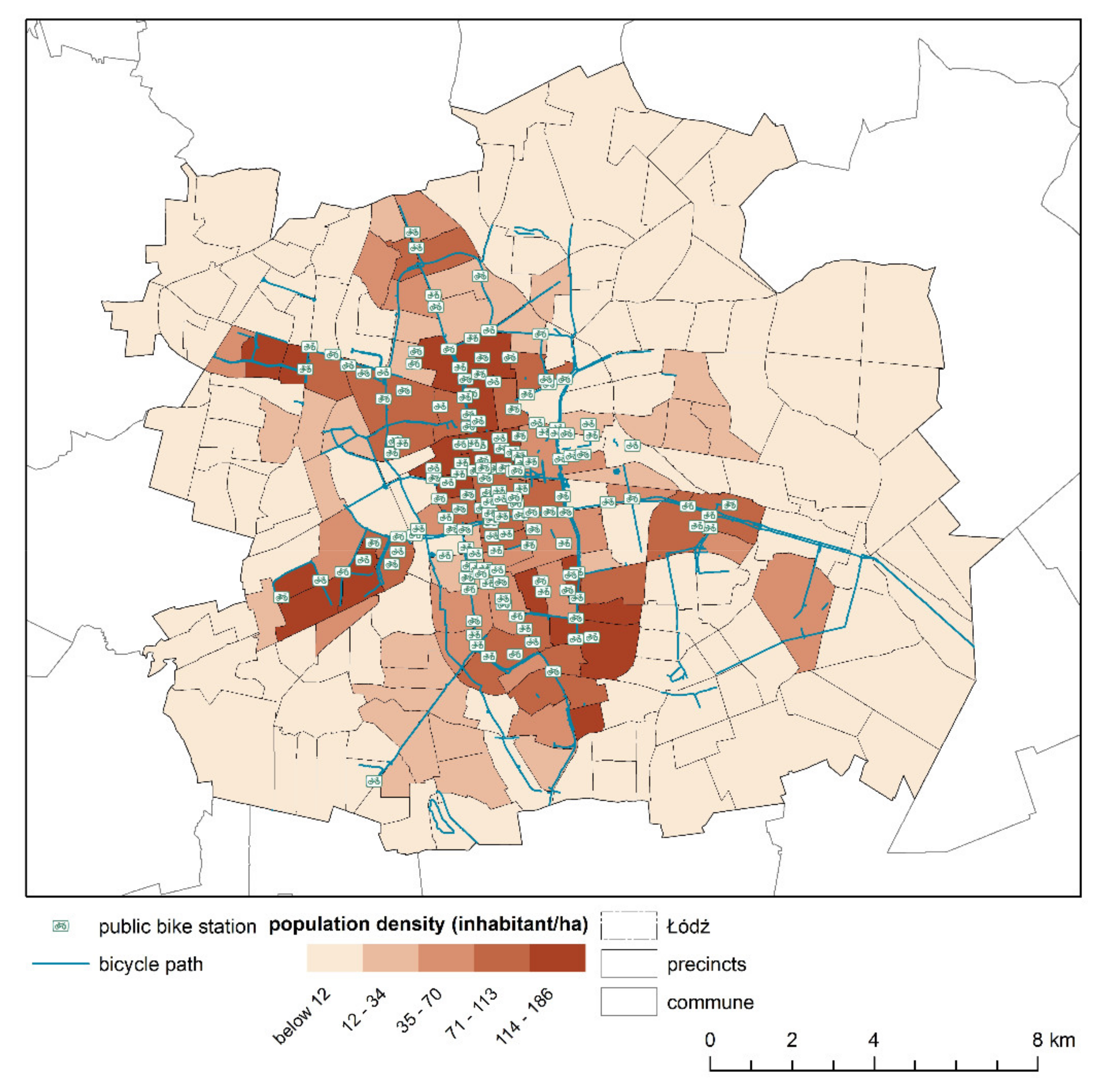
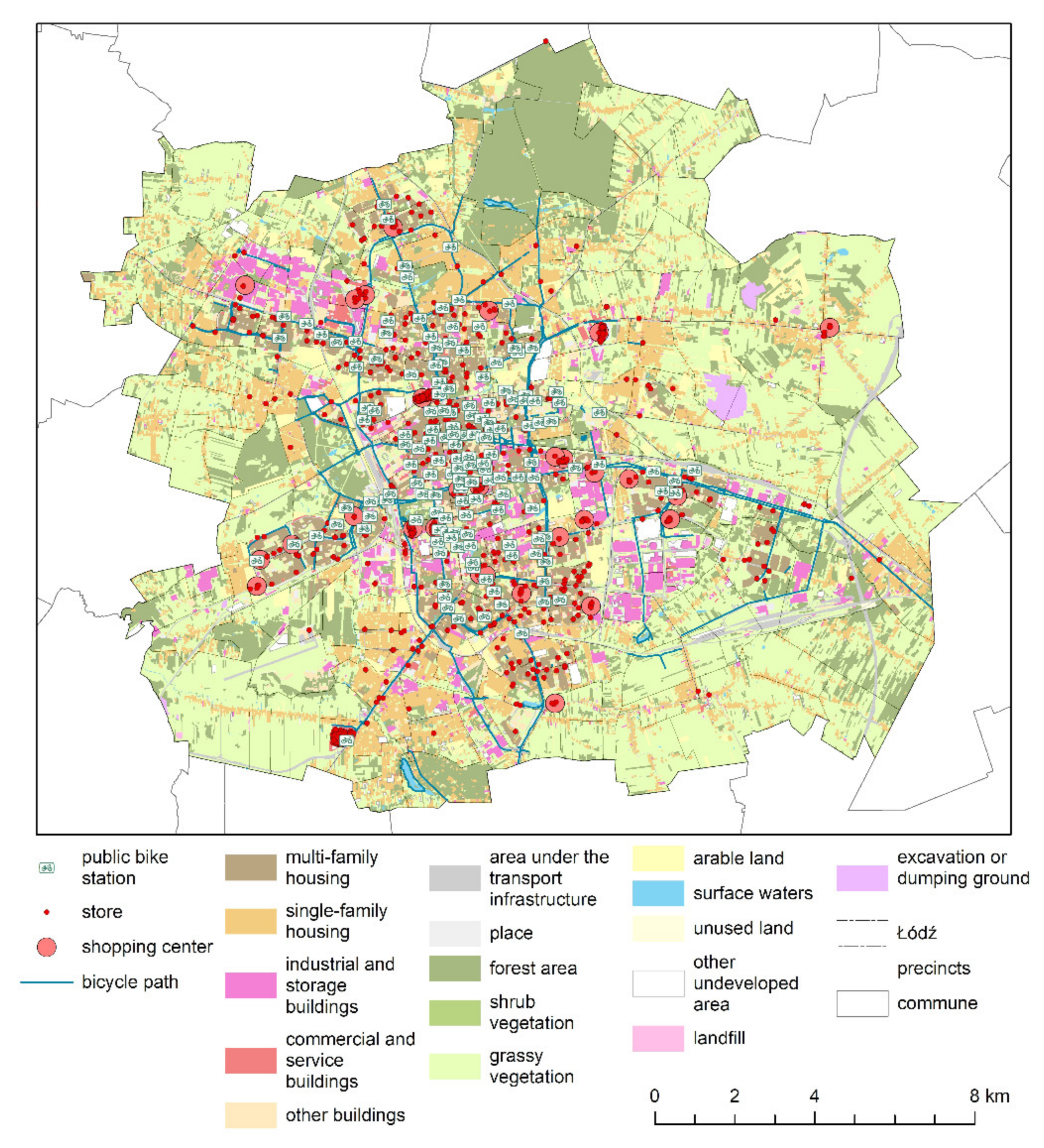


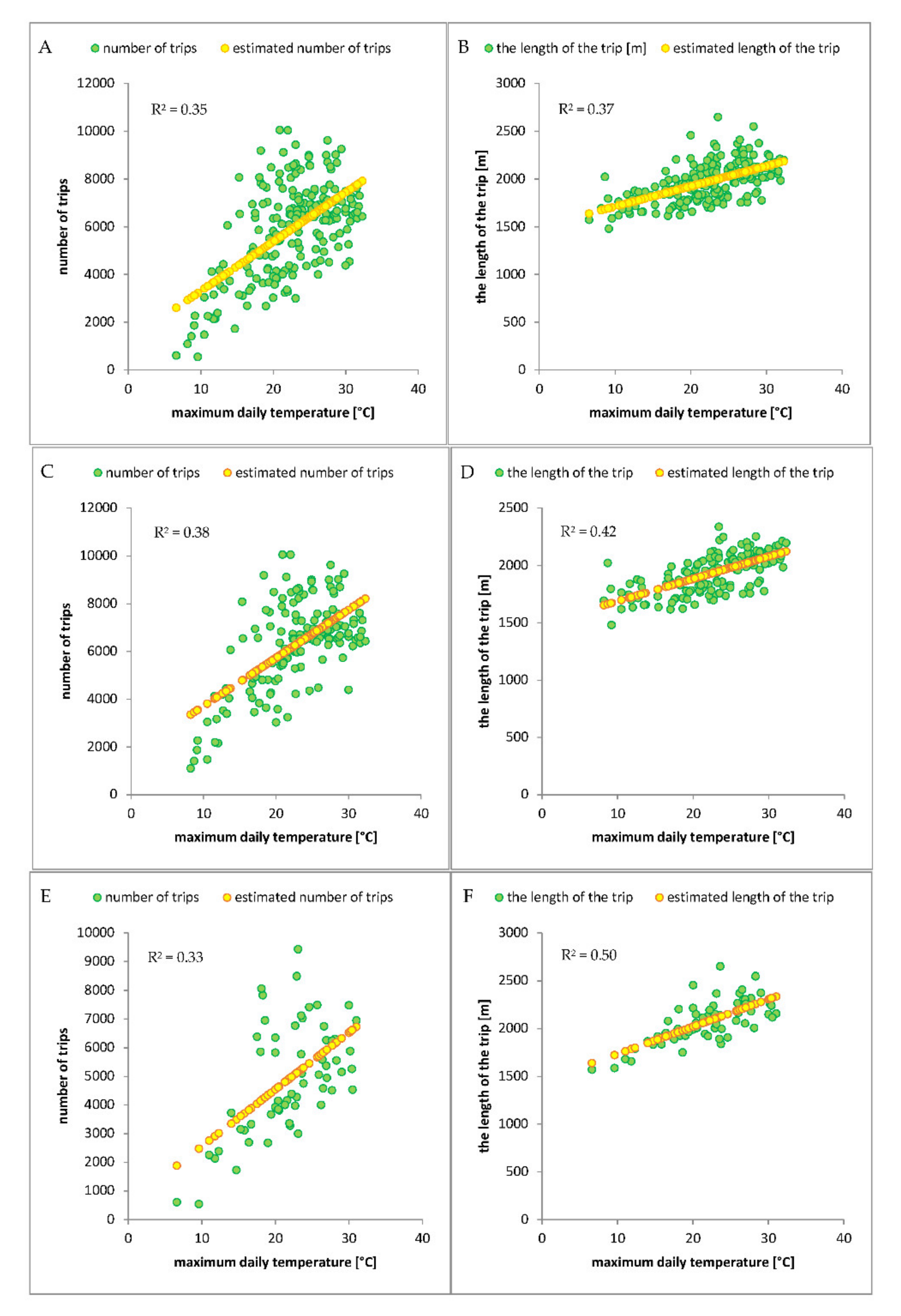


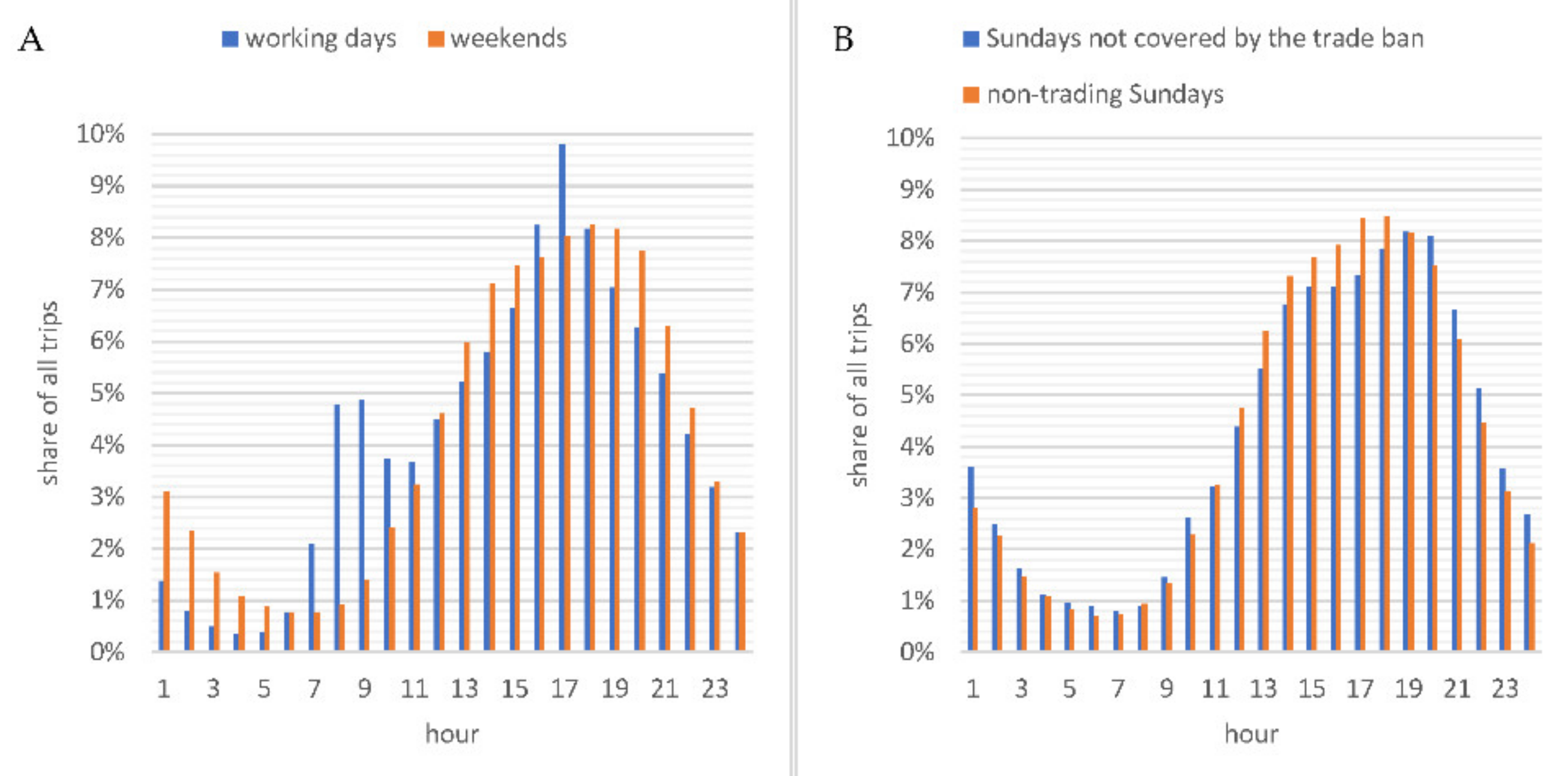
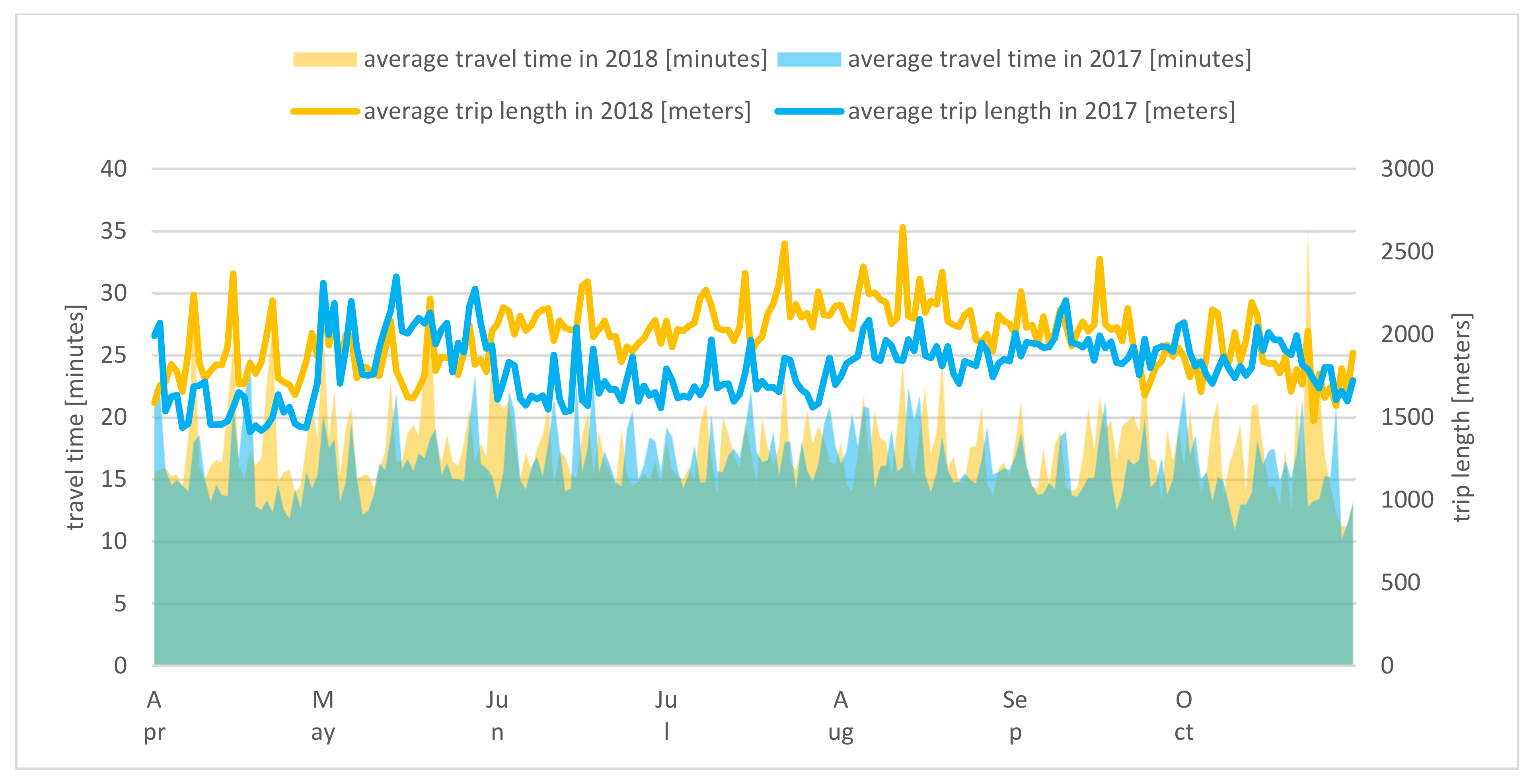
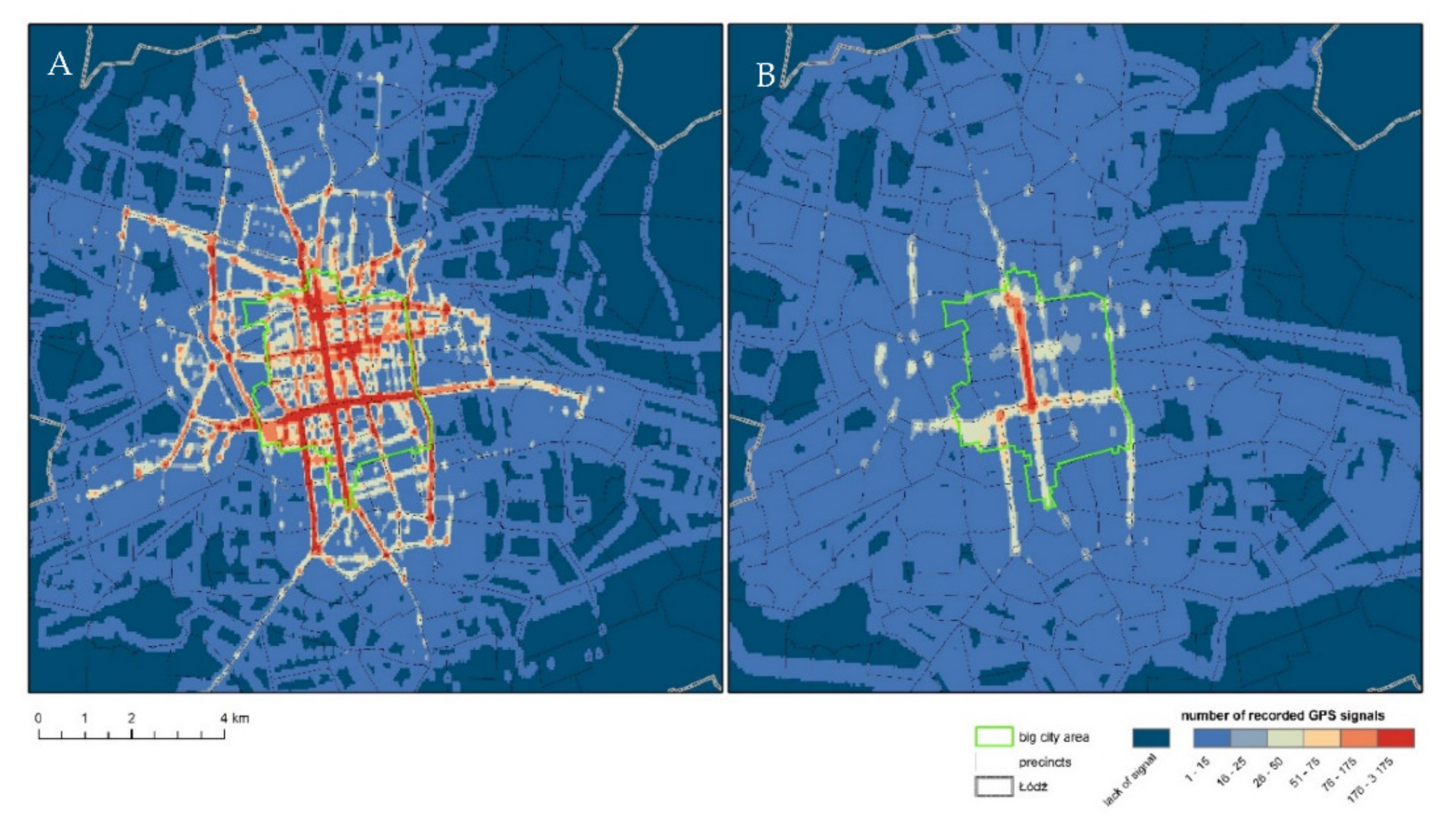
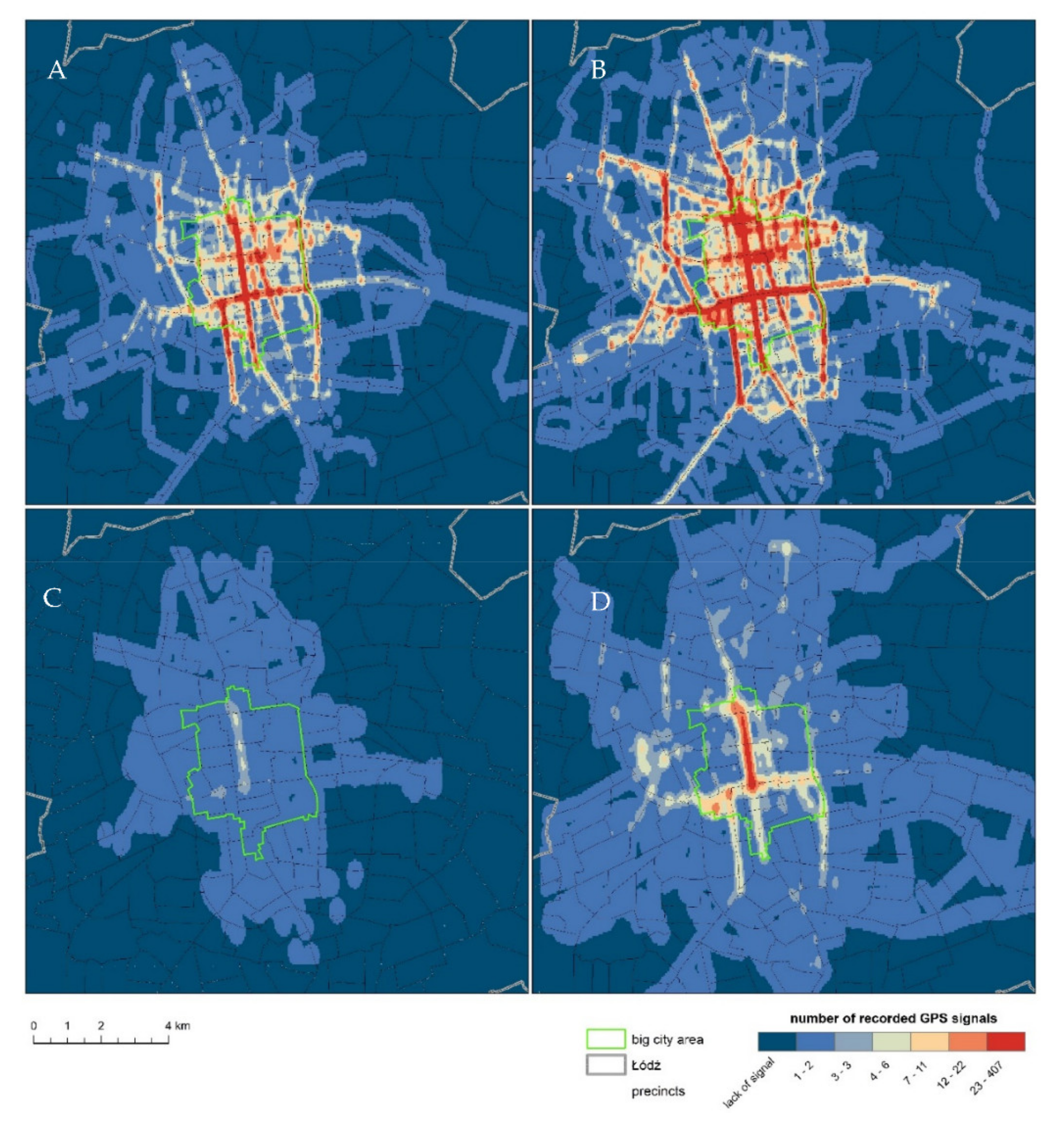
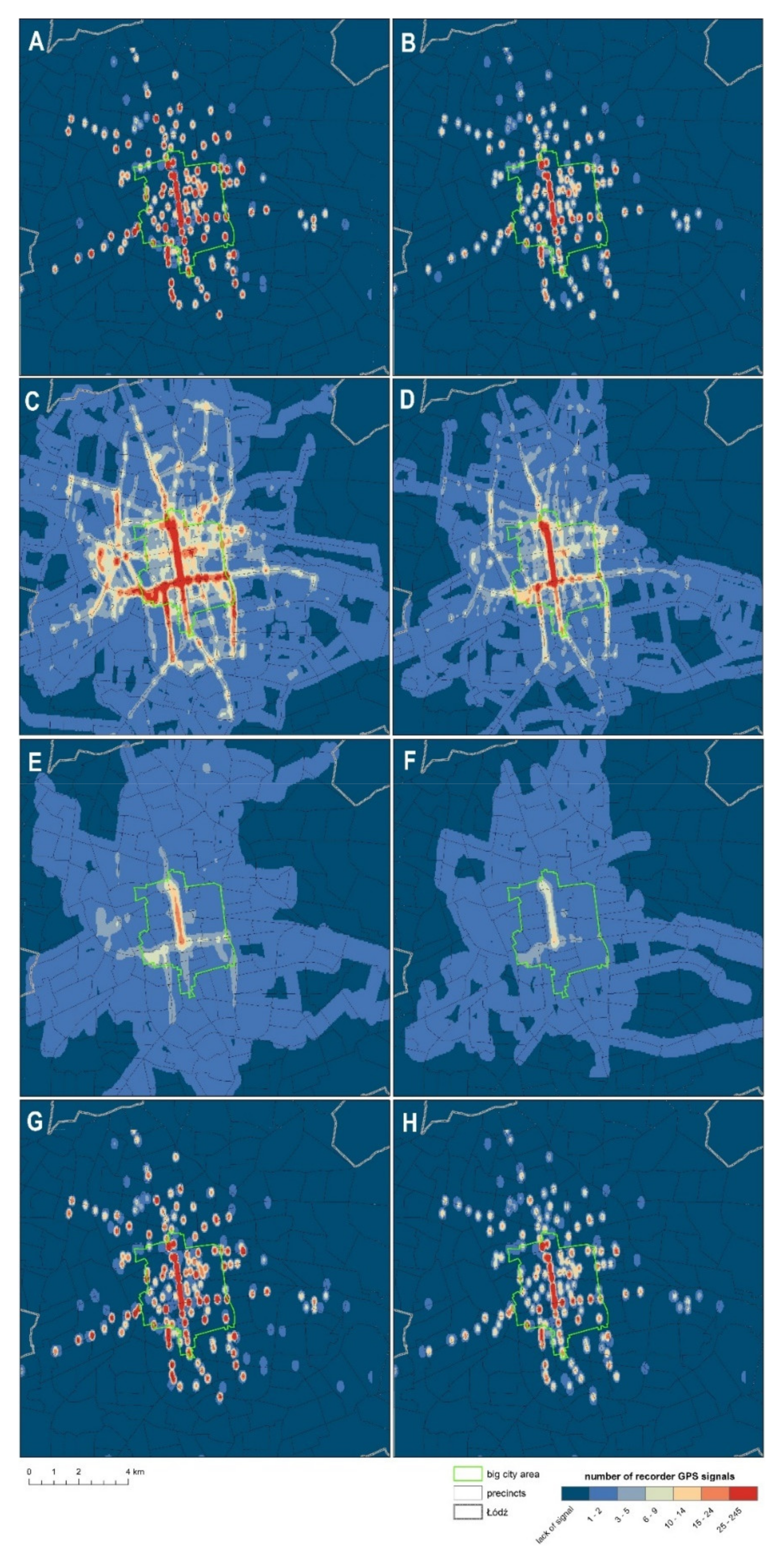
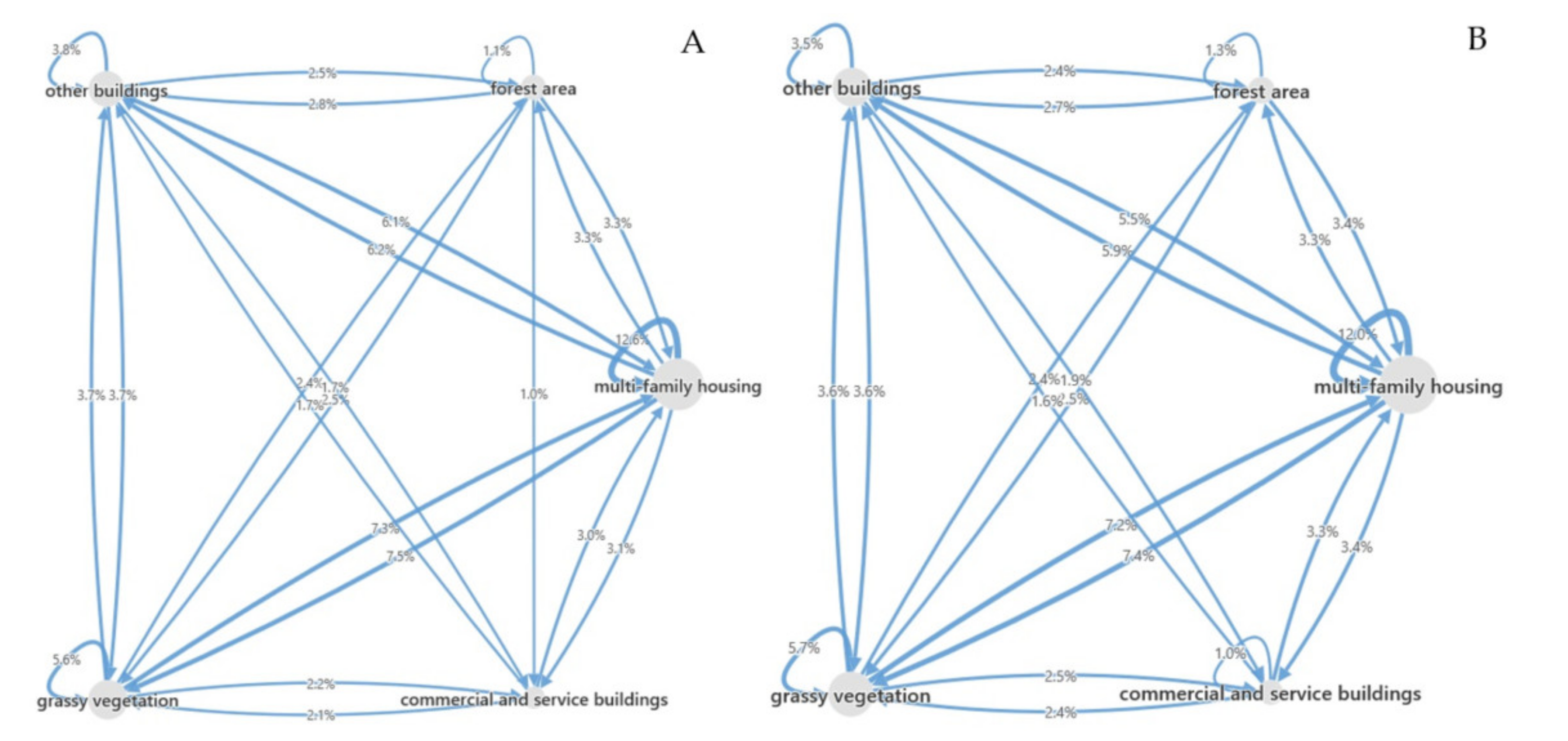
| No. of Trips | Average Travel Time | Average Length | Average Speed | |
|---|---|---|---|---|
| trips taken throughout the week | ||||
| maximum daily temperature [°C] | 0.594 | 0.040 | 0.604 | −0.058 |
| minimum daily temperature [°C] | 0.198 | 0.007 | 0.474 | 0.147 |
| daily total of precipitation [mm] | −0.361 | 0.107 | −0.162 | 0.124 |
| trips taken from Monday to Friday | ||||
| maximum daily temperature [°C] | 0.618 | −0.035 | 0.649 | −0.126 |
| minimum daily temperature [°C] | 0.219 | 0.058 | 0.559 | 0.094 |
| daily total of precipitation [mm] | −0.369 | 0.334 | −0.104 | 0.057 |
| trips taken on weekends | ||||
| maximum daily temperature [°C] | 0.577 | 0.307 | 0.710 | −0.113 |
| minimum daily temperature [°C] | 0.122 | −0.021 | 0.461 | 0.258 |
| daily total of precipitation [mm] | −0.421 | −0.301 | −0.287 | 0.334 |
| Day | Percentage of Total Trips | Average Trip Duration [min] | Average Trip Length [m] | Average Speed [km/h] | Average Max. Daily Temperature [°C] | Average Min. Daily Temperature [°C] | Average Daily Precipitation [mm] | Total of Daily Precipitation [mm] |
|---|---|---|---|---|---|---|---|---|
| Mon | 15.0% | 16.3 | 1912.2 | 10.9 | 22.1 | 9.2 | 1.6 | 47.9 |
| Tue | 15.3% | 16.9 | 1934.3 | 11.0 | 22.2 | 9.7 | 2.0 | 61.9 |
| Wed | 15.0% | 16.8 | 1938.5 | 11.0 | 22.8 | 9.3 | 2.1 | 65.2 |
| Thu | 15.6% | 17.4 | 1945.7 | 10.9 | 23.9 | 11.2 | 1.6 | 46.7 |
| Fri | 15.2% | 16.5 | 1948.3 | 10.9 | 22.9 | 11.3 | 2.5 | 74.9 |
| Sat | 12.3% | 18.4 | 2014.5 | 10.4 | 22.0 | 9.9 | 0.7 | 21.8 |
| Sun | 11.7% | 21.3 | 2137.7 | 10.2 | 22.0 | 9.2 | 2.8 | 87.1 |
| trading Sun | 4.3% | 19.4 | 2042.5 | 10.4 | 21.4 | 10.2 | 3.9 | 51.0 |
| non-trading Sun | 7.4% | 22.6 | 2206.5 | 10.0 | 22.3 | 8.5 | 2.0 | 36.1 |
| Type of Land Cover | Percentage of Starting Points | Percentage of Intermediate Points | Percentage of Destinations | |||
|---|---|---|---|---|---|---|
| Trading Sundays | Non-Trading Sundays | Trading Sundays | Non-Trading Sundays | Trading Sundays | Non-Trading Sundays | |
| multi-family housing | 33.2% | 34.0% | 32.1% | 27.7% | 32.8% | 33.7% |
| single-family housing | 0.9% | 1.0% | 3.5% | 4.2% | 0.9% | 1.0% |
| industrial buildings | 0.4% | 0.4% | 1.8% | 1.9% | 0.5% | 0.5% |
| commercial and service buildings | 9.6% | 8.9% | 7.6% | 7.8% | 10.0% | 9.2% |
| other buildings | 18.2% | 18.8% | 12.5% | 11.7% | 18.4% | 19.1% |
| place | 11.5% | 11.4% | 7.3% | 6.9% | 11.0% | 10.9% |
| grassy vegetation | 22.5% | 22.2% | 22.3% | 25.0% | 22.9% | 22.6% |
| shrub vegetation | 0.0% | 0.0% | 0.0% | 0.0% | 0.0% | 0.0% |
| forest area | 3.3% | 2.8% | 10.7% | 12.5% | 3.3% | 2.7% |
| agricultural land | 0.0% | 0.0% | 1.0% | 1.4% | 0.0% | 0.0% |
| surface waters | 0.0% | 0.0% | 0.2% | 0.2% | 0.0% | 0.0% |
| unused land | 0.0% | 0.0% | 0.1% | 0.1% | 0.0% | 0.0% |
| other undeveloped area | 0.4% | 0.5% | 0.8% | 0.8% | 0.2% | 0.3% |
| Starting Points | Intermediate Points | Destinations | Percentage of Trips | ||
|---|---|---|---|---|---|
| Trading Sundays | Non-Trading Sundays | ||||
| within the Urban Core Zone | + | + | + | 34.3% | 23.6% |
| + | + | − | 9.0% | 8.8% | |
| + | − | − | 8.7% | 8.3% | |
| − | + | + | 10.7% | 10.1% | |
| − | − | + | 7.3% | 8.0% | |
| − | − | − | 24.3% | 32.7% | |
| + | − | + | 3.0% | 4.4% | |
| − | + | − | 2.7% | 4.1% | |
| Destination | ||||||
|---|---|---|---|---|---|---|
| Docking Station Within the Urban Core Zone | Docking Station Outside the Urban Core Zone | Outside Docking Station Within the Urban Core Zone | Outside Docking Station Outside the Urban Core Zone | |||
| starting point | trading Sundays | docking station within the Urban Core Zone | 10.6% | 2.6% | 10.2% | 7.8% |
| docking station outside the Urban Core Zone | 2.6% | 1.6% | 1.9% | 4.7% | ||
| docking station outside the Urban Core Zone | 10.0% | 2.3% | 10.1% | 6.4% | ||
| outside docking station outside the Urban Core Zone | 6.7% | 4.4% | 5.6% | 12.5% | ||
| non-trading Sundays | docking station within the Urban Core Zone | 10.3% | 2.6% | 9.8% | 7.8% | |
| docking station outside the Urban Core Zone | 2.4% | 1.8% | 1.9% | 5.2% | ||
| docking station outside the Urban Core Zone | 9.8% | 2.1% | 8.7% | 6.1% | ||
| outside docking station outside the Urban Core Zone | 7.1% | 5.0% | 5.5% | 13.9% | ||
Publisher’s Note: MDPI stays neutral with regard to jurisdictional claims in published maps and institutional affiliations. |
© 2021 by the authors. Licensee MDPI, Basel, Switzerland. This article is an open access article distributed under the terms and conditions of the Creative Commons Attribution (CC BY) license (https://creativecommons.org/licenses/by/4.0/).
Share and Cite
Borowska-Stefańska, M.; Mikusova, M.; Kowalski, M.; Kurzyk, P.; Wiśniewski, S. Changes in Urban Mobility Related to the Public Bike System with Regard to Weather Conditions and Statutory Retail Restrictions. Remote Sens. 2021, 13, 3597. https://doi.org/10.3390/rs13183597
Borowska-Stefańska M, Mikusova M, Kowalski M, Kurzyk P, Wiśniewski S. Changes in Urban Mobility Related to the Public Bike System with Regard to Weather Conditions and Statutory Retail Restrictions. Remote Sensing. 2021; 13(18):3597. https://doi.org/10.3390/rs13183597
Chicago/Turabian StyleBorowska-Stefańska, Marta, Miroslava Mikusova, Michał Kowalski, Paulina Kurzyk, and Szymon Wiśniewski. 2021. "Changes in Urban Mobility Related to the Public Bike System with Regard to Weather Conditions and Statutory Retail Restrictions" Remote Sensing 13, no. 18: 3597. https://doi.org/10.3390/rs13183597
APA StyleBorowska-Stefańska, M., Mikusova, M., Kowalski, M., Kurzyk, P., & Wiśniewski, S. (2021). Changes in Urban Mobility Related to the Public Bike System with Regard to Weather Conditions and Statutory Retail Restrictions. Remote Sensing, 13(18), 3597. https://doi.org/10.3390/rs13183597









